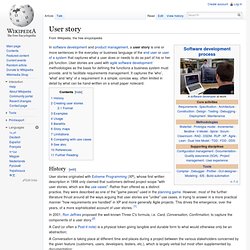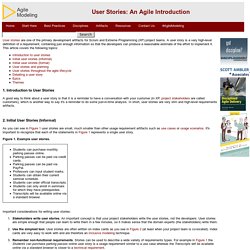

User story. History[edit] User stories originated with Extreme Programming (XP), whose first written description in 1998 only claimed that customers defined project scope "with user stories, which are like use cases".

Rather than offered as a distinct practice, they were described as one of the "game pieces" used in the planning game. However, most of the further literature thrust around all the ways arguing that user stories are "unlike" use cases, in trying to answer in a more practical manner "how requirements are handled" in XP and more generally Agile projects. This drives the emergence, over the years, of a more sophisticated account of user stories. [1] In 2001, Ron Jeffries proposed the well-known Three C's formula, i.e. A Card (or often a Post-it note) is a physical token giving tangible and durable form to what would otherwise only be an abstraction; The Confirmation, the more formal the better, ensures that the objectives the conversation revolved around have been reached finally.
Run tests. Introduction to User Stories. 1.

Introduction to User Stories A good way to think about a user story is that it is a reminder to have a conversation with your customer (in XP, project stakeholders are called customers), which is another way to say it's a reminder to do some just-in-time analysis. In short, user stories are very slim and high-level requirements artifacts. 2. Initial User Stories (Informal) As you can see in Figure 1 user stories are small, much smaller than other usage requirement artifacts such as use cases or usage scenarios. Figure 1. Important considerations for writing user stories: Stakeholders write user stories. Figure 2. 2. Figure 3. 4. There are two areas where user stories affect the planning process on agile projects: Scheduling.
Figure 4. 5. Facebook广告API又推重磅,广告优化的参考指标被大大扩展. 先前我们网站曾撰文《 Facebook对Google的威胁在哪?

看看两大巨头的“广告生成工具”你就明白了》,其中披露了 Facebook 强大的广告生成工具。 现在,Facebook 广告 API 又推重磅:广告商通过这个新型 API,可以让广告专门显示给那些在点击广告之后最有可能开展一系列后续活动的用户,比如将一个品牌内容分享到其他新闻流中,在应用内购买虚拟商品,或者将 Facebook 上面提供的买家优惠在实体商店兑现等等。 先前,Facebook 的广告 API 和自助工具只允许广告商根据广告点击,用户喜欢的页面,用户是否安装某款应用,用户是否签到等几个指标进行广告优化。 现在,广告商的参考指标被进一步扩展,包括: 用户讨论的内容(是否有用户在讨论广告相关的内容) 用户喜欢哪些页面 用户喜欢哪些帖子 帖子的评论 有哪些用户分享了这个帖子 @中的内容 用户签到 照片标签 被分享的商店优惠 有哪些用户认领了优惠 用户安装应用的情况. Wordpress 图片类主题瀑布流实现方案. KISSY - Keep It Simple & Stupid, Short & Sweet, Slim & Sexy...
Developer - Creating a 'Hello World' Sproutcore application for OpenSocial. This tutorial could also be titled: How to turn a Sproutcore application into an OpenSocial application.

We will run through writing a Hello World OpenSocial application using SproutCore. We will start from the basics of installing sproutcore before teaching you how to create a sproutcore application and turning it into an OpenSocial application. Finally, we'll finish by showing you how to deploy the application on your web server. Installing Sproutcore In this tutorial, we will be using the latest stable release of sproutcore, which we will install using Rubygems. Once you've installed RVM, you can see a list of ruby versions on your machine by using: rvm list When I run this on my machine, I see the following: rvm rubies => ruby-1.8.7-p302 [ i386 ] ruby-1.8.6-p399 [ i386 ] ruby-1.9.1-p378 [ i386 ] The arrow points to ruby-1.8.7 which is the version I'm using. jQuery Masonry. 社会化评论系统 - WordPress插件. Comet:基于 HTTP 长连接的“服务器推”技术.
“服务器推”技术的应用 传统模式的 Web 系统以客户端发出请求、服务器端响应的方式工作。

这种方式并不能满足很多现实应用的需求,譬如: 监控系统:后台硬件热插拔、LED、温度、电压发生变化; 即时通信系统:其它用户登录、发送信息; 即时报价系统:后台数据库内容发生变化; 这些应用都需要服务器能实时地将更新的信息传送到客户端,而无须客户端发出请求。 “服务器推”技术在现实应用中有一些解决方案,本文将这些解决方案分为两类:一类需要在浏览器端安装插件,基于套接口传送信息,或是使用 RMI、CORBA 进行远程调用;而另一类则无须浏览器安装任何插件、基于 HTTP 长连接。 将“服务器推”应用在 Web 程序中,首先考虑的是如何在功能有限的浏览器端接收、处理信息: 客户端如何接收、处理信息,是否需要使用套接口或是使用远程调用。 回页首 基于客户端套接口的“服务器推”技术 Flash XMLSocket 如果 Web 应用的用户接受应用只有在安装了 Flash 播放器才能正常运行, 那么使用 Flash 的 XMLSocket 也是一个可行的方案。 这种方案实现的基础是: Flash 提供了 XMLSocket 类。 具体实现方法:在 HTML 页面中内嵌入一个使用了 XMLSocket 类的 Flash 程序。 关于如何去构建充当了 JavaScript 与 Flash XMLSocket 桥梁的 Flash 程序,以及如何在 JavaScript 里调用 Flash 提供的接口,我们可以参考 AFLAX(Asynchronous Flash and XML)项目提供的 Socket Demo 以及 SocketJS(请参见 参考资源)。
Javascript 与 Flash 的紧密结合,极大增强了客户端的处理能力。 客户端必须安装 Flash 播放器; 因为 XMLSocket 没有 HTTP 隧道功能,XMLSocket 类不能自动穿过防火墙; 因为是使用套接口,需要设置一个通信端口,防火墙、代理服务器也可能对非 HTTP 通道端口进行限制; 不过这种方案在一些网络聊天室,网络互动游戏中已得到广泛使用。 Java Applet 套接口 这种方案最大的不足在于 Java applet 在收到服务器端返回的信息后,无法通过 JavaScript 去更新 HTML 页面的内容。 Comet 简介 图 1. 小结 学习.